Dosing Free Nitrous Acid as an Alternative Sulphide Control Technology for Pressure Sewers in Germany
Abstract
1. Introduction
2. Materials and Methods
2.1. Sewer Pilot Plant
2.2. Dosing Trials Scheme
2.3. Monitoring and Sampling
2.4. Chemical Analysis
3. Results and Discussion
3.1. Baseline Sulphide Monitoring
3.2. Effectiveness during the FNA Dosing Event
3.3. Biocidal Effects
3.4. Impact of Rain Events
3.5. Possible Side Effects
3.6. Practical Implications and Usage in Germany
4. Conclusions
Author Contributions
Funding
Institutional Review Board Statement
Informed Consent Statement
Data Availability Statement
Acknowledgments
Conflicts of Interest
Appendix A
Appendix A.1. Conversion of the Bisulphide (HS−) to Total Dissolved-Sulphide (ST)
Appendix A.2. Summary of the Hach Lange Cuvette Test Kits Used in the Study
| Parameter | Cuvette Test | Range |
|---|---|---|
| Sulphate | LCK 153 | 40–150 mg/L |
| COD | LCK 114 | 150–1000 mg/L |
| Nitrite | LCK 341/342 | 0.015–0.6/0.6–6 mg N-NO2−/L |
| Nitrate | LCK 339 | 0.23–13.5 mg N-NO3−/L |
Appendix A.3. Response of Pressure Sewer Biofilms to the FNA Dosing

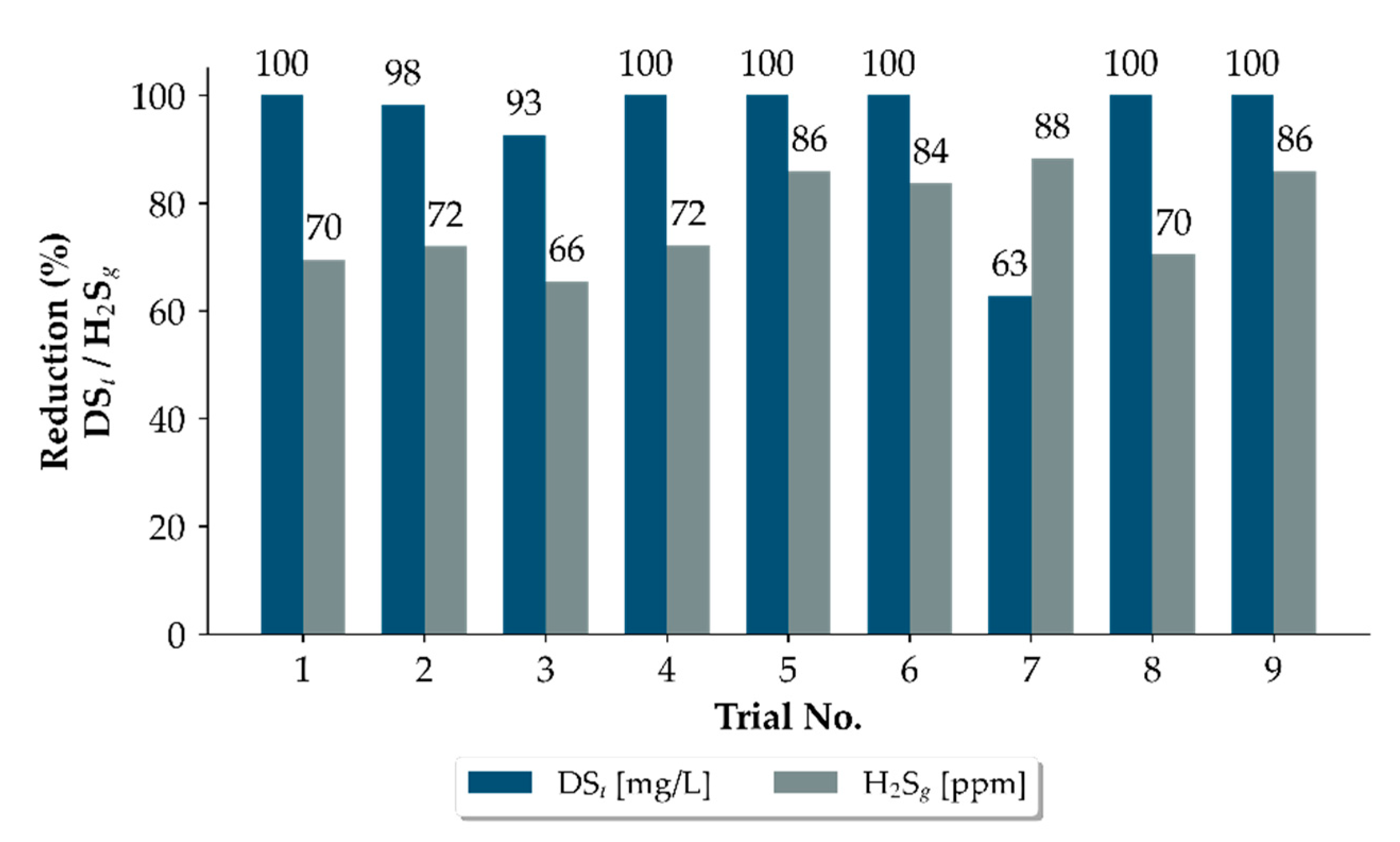
Appendix A.4. Fitting the Recovery of H2S Gas Release
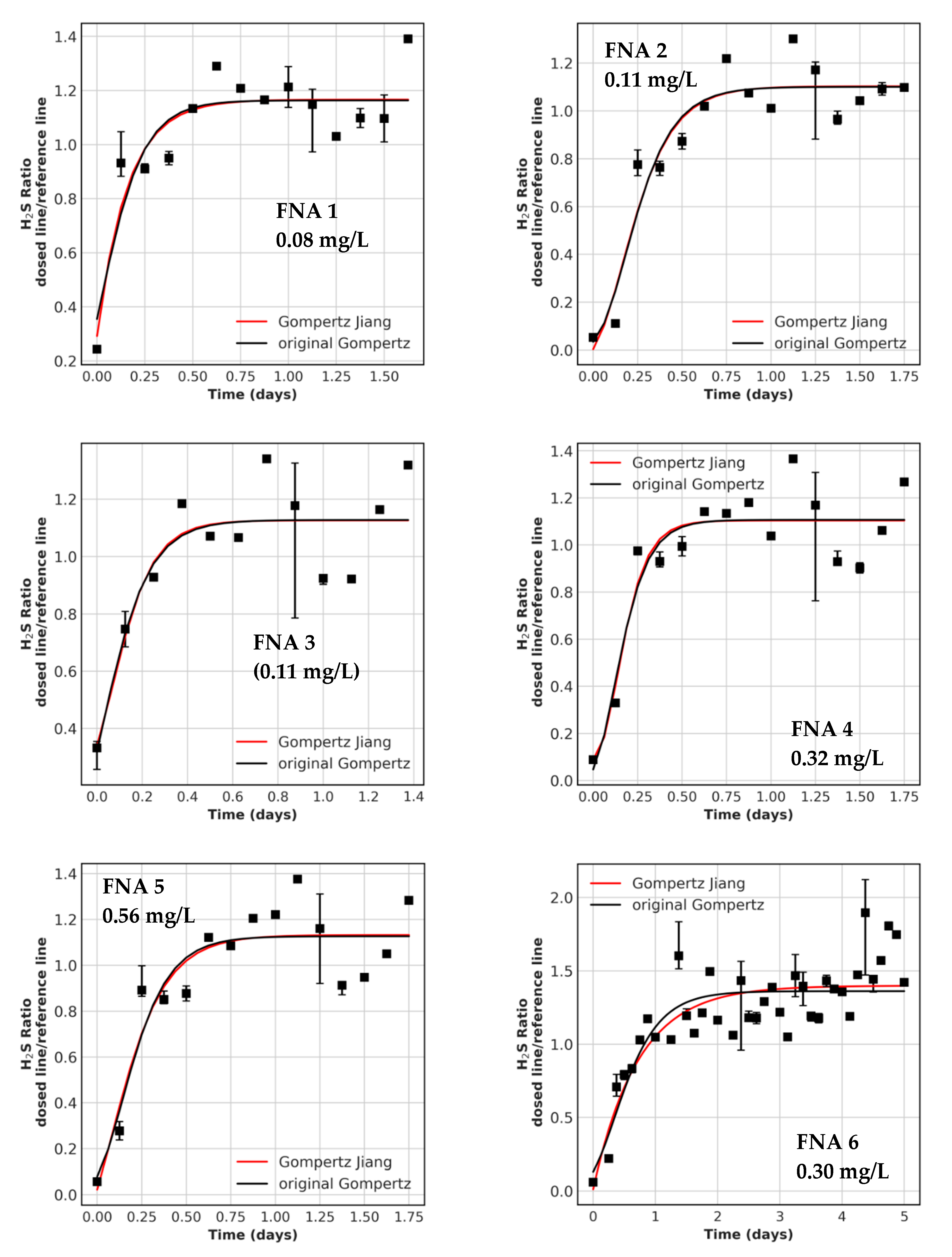
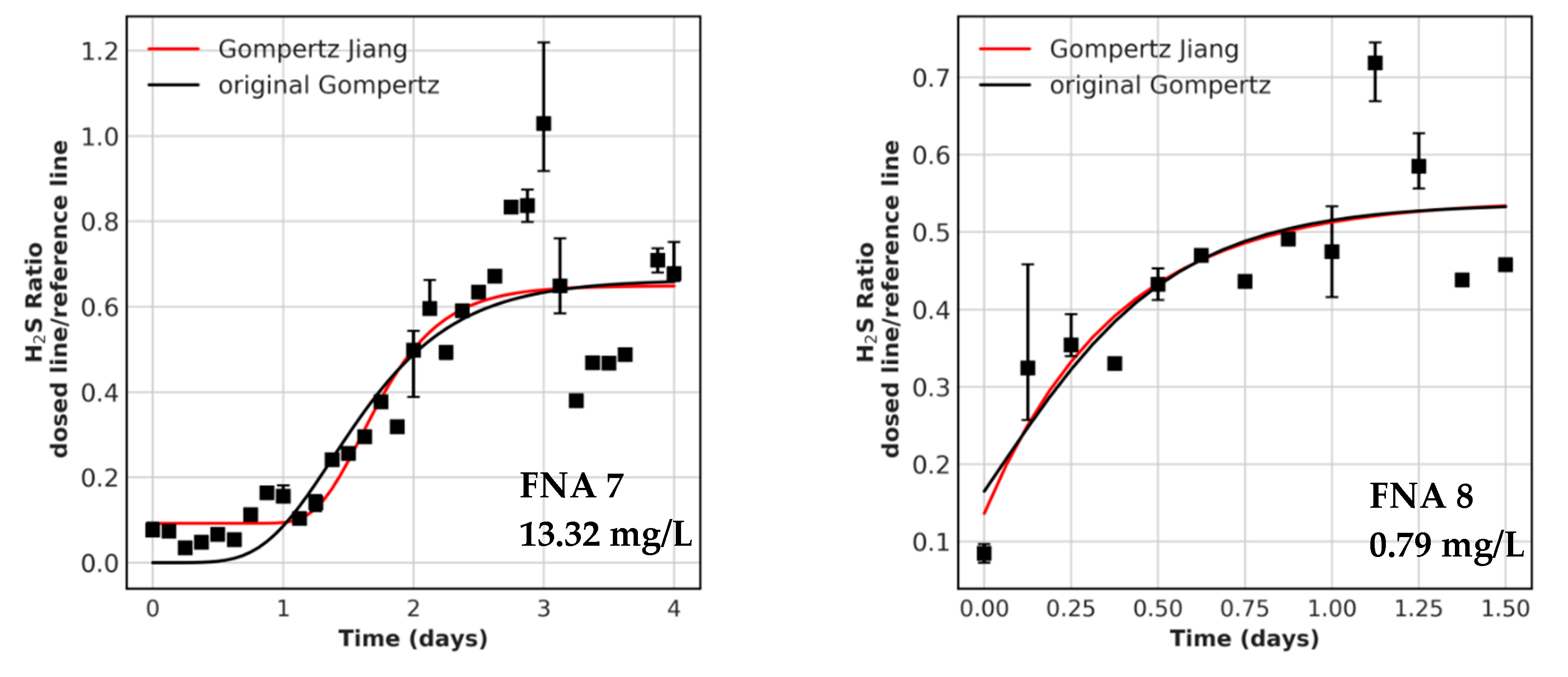
References
- Butler, D.; Digman, C.J.; Makropoulos, C.; Davies, J.W. Pump systems. In Urban Drainage, 4th ed.; Taylor & Francis Group: Abingdon, UK; CRC Press: Boca Raton, FL, USA, 2018; p. 293. ISBN 978-1-4987-5060-8. [Google Scholar]
- Boon, A. Septicity in sewers: Causes, consequences and containment. Water Sci. Technol. 1995, 31, 237–253. [Google Scholar] [CrossRef]
- Kiilerich, B.; Nielsen, A.H.; Vollertsen, J. Kinetics of sulfide precipitation with ferrous and ferric iron in wastewater. Water Sci. Technol. 2018, 78, 1071–1081. [Google Scholar] [CrossRef]
- Hvitved-Jacobsen, T.; Vollertsen, J.; Nielsen, A.H. Sewer Processes: Microbial and Chemical Process Engineering of Sewer Networks, 2nd ed.; CRC Press: Boca Raton, FL, USA, 2013; pp. 10, 21, 222–223. ISBN 978-1-4398-8178-1. [Google Scholar]
- Berger, C.; Falk, C.; Hetzel, F.; Pinnekamp, J.; Roder, S.; Ruppelt, J. Zustand der Kanalisation in Deutschland. Zustand Kanalis. Dtschl. 2016, 2016, 498–508. [Google Scholar] [CrossRef]
- Zhang, L.L.; Ma, J.; Jin, Y.Y.; Zhang, H.H.; Liu, Y.Y.; Cai, L.L. Abatement of sulfide generation in sewage by glutaraldehyde supplementation and the impact on the activated sludge accordingly. Front. Environ. Sci. Eng. 2014, 9, 365–370. [Google Scholar] [CrossRef]
- Ott, F. Untersuchungen von ausgewählten Maßnahmen zur Verringerung der Geruchsproblematik in Abwassernetzen unter Berücksichtigung von Erfahrungen aus der Praxis. Master’s Thesis, University of Rostock, Rostock, Germany, 2004. [Google Scholar]
- Barjenbruch, M. Geruchsbelästigungen—die biogene Schwefelsäurebildung in Kanälen Ursachen und Maßnahmen. In Proceedings of the Geruchsbelaestigungen—Ursachen und Massnahmen, Berlin, Germany, 12 October 2007; p. 4. [Google Scholar]
- Dombrowski, E.-M.; Gnirss, R.; Kokles, S.; Sperlich, A. Wasserwerksschlämme Kontra Geruch Und Korrosion. WWT Online 2015, 7-8/2015, 29–33. [Google Scholar]
- Auguet, O.; Pijuan, M.; Guasch-Balcells, H.; Borrego, C.M.; Gutierrez, O. Implications of downstream nitrate dosage in anaerobic sewers to control sulfide and methane emissions. Water Res. 2015, 68, 522–532. [Google Scholar] [CrossRef]
- Kiilerich, B.; Van De Ven, W.; Nielsen, A.H.; Vollertsen, J. Sulfide precipitation in wastewater at short timescales. Water 2017, 9, 670. [Google Scholar] [CrossRef]
- Jiang, G.; Keating, A.; Corrie, S.; O’Halloran, K.; Nguyen, L.; Yuan, Z. Dosing free nitrous acid for sulfide control in sewers: Results of field trials in Australia. Water Res. 2013, 47, 4331–4339. [Google Scholar] [CrossRef]
- Gutierrez, O.; Sudarjanto, G.; Ren, G.; Ganigué, R.; Jiang, G.; Yuan, Z. Assessment of pH shock as a method for controlling sulfide and methane formation in pressure main sewer systems. Water Res. 2014, 48, 569–578. [Google Scholar] [CrossRef]
- Jiang, G.; Gutierrez, O.; Sharma, K.R.; Keller, J.; Yuan, Z. Optimization of intermittent, simultaneous dosage of nitrite and hydrochloric acid to control sulfide and methane productions in sewers. Water Res. 2011, 45, 6163–6172. [Google Scholar] [CrossRef]
- Yan, X.; Sun, J.; Kenjiahan, A.; Dai, X.; Ni, B.-J.; Yuan, Z. Rapid and strong biocidal effect of ferrate on sulfidogenic and methanogenic sewer biofilms. Water Res. 2020, 169, 115208. [Google Scholar] [CrossRef] [PubMed]
- Shultz, C.; Nostro, M.; Weidl, D. New technology for biofilm removal and hydrogen sulfide control in sewer lines: Lake Nona Trial. Fla. Water Resour. J. 2017, 68, 14–17. [Google Scholar]
- Gao, S.-H.; Ho, J.Y.; Fan, L.; Richardson, D.J.; Yuan, Z.; Bond, P.L. antimicrobial effects of free nitrous acid on Desulfovibrio vulgaris: Implications for sulfide-induced corrosion of concrete. Appl. Environ. Microbiol. 2016, 82, 5563–5575. [Google Scholar] [CrossRef]
- Gutierrez, O.; Sudarjanto, G.; Sharma, K.R.; Keller, J.; Yuan, Z. SCORe-CT: A new method for testing effectiveness of sulfide-control chemicals used in sewer systems. Water Sci. Technol. 2011, 64, 2381–2388. [Google Scholar] [CrossRef]
- Anthonisen, A.C.; Loehr, R.C.; Prakasam, T.B.; Srinath, E.G. Inhibition of nitrification by ammonia and nitrous acid. J. Water Pollut. Control. Fed. 1976, 48, 835–852. [Google Scholar]
- DIN Deutsches Institut für Normung e.V. German Standard Methods for the Examination of Water, Wastewater and Sludge—Parameters Characterizing Effects and Substances (Group H)—Part 7: Determination of Acid and Base-Neutralizing Capacities (H 7); DIN 38409-7; Beuth Verlag: Berlin, Germany, 2005. [Google Scholar]
- Huisman, J.L. Transport and Transformation Processes in Combined Sewers. Ph.D. Thesis, ETH Zurich, Zurich, Germany, 2001; pp. 21–22. [Google Scholar]
- Jiang, G.; Gutierrez, O.; Sharma, K.R.; Yuan, Z. Effects of nitrite concentration and exposure time on sulfide and methane production in sewer systems. Water Res. 2010, 44, 4241–4251. [Google Scholar] [CrossRef] [PubMed]
- Ma, B.; Bao, P.; Wei, Y.; Zhu, G.; Yuan, Z.; Peng, Y. Suppressing nitrite-oxidizing bacteria growth to achieve nitrogen removal from domestic wastewater via anammox using intermittent aeration with low dissolved oxygen. Sci. Rep. 2015, 5, 13048. [Google Scholar] [CrossRef]
- Saračević, E. Zur Kenntnis der Schwefelwasserstoffbildung und -vermeidung in Abwasserdruckleitungen; Inst. für Wassergüte, Ressourcenmanagement und Abfallwirtschaft, Technische Universität Wien: Wien, Austria, 2009; pp. 15–16. ISBN 978-3-85234-103-3. [Google Scholar]
- DIN Deutsches Institut für Normung e.V. German Standard Methods for the Examination of Water, Waste Water and Sludge—Anions (Group D)—Part 27: Determination of Sulfide by Gas Extraction Method (D 27); DIN 384405-D 27; Beuth Verlag: Berlin, Germany, 2016. [Google Scholar]
- APHA American Public Health Association. Standard methods for the examination of water and wastewater. In “4500-S2—SULFIDE”, Standard Methods for the Examination of Water and Wastewater; APHA-AWWA-WEF: Washington, DC, USA, 2018. [Google Scholar] [CrossRef]
- Shypanski, A.H.; Yuan, Z.; Sharma, K. Influence of pressure main pumping frequency on sulfide formation rates in sanitary sewers. Environ. Sci. Water Res. Technol. 2018, 38, 92. [Google Scholar] [CrossRef]
- Liang, Z.-S.; Sun, J.; Chau, H.K.-M.; Leong, E.I.-M.; Wu, D.; Chen, G.-H.; Jiang, F. Experimental and modelling evaluations of sulfide formation in a mega-sized deep tunnel sewer system and implications for sewer management. Environ. Int. 2019, 131, 105011. [Google Scholar] [CrossRef] [PubMed]
- Geruchsemissionen aus Entwässerungssystemen: Vermeidung oder Verminderung; ATV-DVWK, Deutsche Vereinigung für Wasserwirtschaft, Abwasser und Abfall, Ed.; ATV-DVWK-Regelwerk Merkblatt; Oktober 2003; ATV-DVWK Deutsche Vereinigung für Wasserwirtschaft, Abwasser und Abfall e.V: Hennef (Sieg), Germany, 2003; ISBN 978-3-924063-82-5.
- Park, K.; Lee, H.; Phelan, S.; Liyanaarachchi, S.; Marleni, N.; Navaratna, D.; Jegatheesan, V.; Shu, L. Mitigation strategies of hydrogen sulphide emission in sewer networks—A review. Int. Biodeterior. Biodegrad. 2014, 95, 251–261. [Google Scholar] [CrossRef]
- Feldhaus, R.; Poppe, A.; Frechen, F.-B.; Frey, M. Beeinflussung von Gewässern und Abwasserreinigung durch die Zugabe von Stoffen in Freispiegelkanälen zur Geruchsminimierung; Fachhochschule Köln: Köln, Germany, 2005; p. 449. [Google Scholar]
- Zuo, Z.; Zheng, M.; Chang, J.; Ren, D.; Huang, X.; Yuan, Z.; Liu, Y. Free nitrous acid-based suppression of sulfide production in sewer sediments: In-situ effect mechanism. Sci. Total Environ. 2020, 715, 136871. [Google Scholar] [CrossRef]
- Jiang, G.; Gutierrez, O.; Yuan, Z. The strong biocidal effect of free nitrous acid on anaerobic sewer biofilms. Water Res. 2011, 45, 3735–3743. [Google Scholar] [CrossRef]
- Jiang, G.; Yuan, Z. Inactivation kinetics of anaerobic wastewater biofilms by free nitrous acid. Appl. Microbiol. Biotechnol. 2013, 98, 1367–1376. [Google Scholar] [CrossRef] [PubMed]
- Weissenberger, J. Betonkorrosion Ein Forschungsprojekt Aus Norwegen.; Hydro-Care, 3.Mai In: Barjenbruch, Germany, 2007; [8]. [Google Scholar]
- Sercombe, D.C.W. The control of septicity and odours in sewerage systems and at sewage treatment works operated by anglian water services limited. Water Sci. Technol. 1995, 31, 283–292. [Google Scholar] [CrossRef]
- Gujer, W. Siedlungswasserwirtschaft: Mit 84 Tabellen; 3., bearb. Aufl.; Springer: Berlin/Heidelberg, Germany, 2007; ISBN 978-3-540-34329-5. [Google Scholar]
- US EPA Inventory of U.S. Greenhaouse Gas Emissions and Sinks 1990–2017; US EPA: Washington, DC, USA, 2019. [Google Scholar]
- Ahn, J.H.; Kim, S.; Park, H.; Rahm, B.; Pagilla, K.; Chandran, K. N2O Emissions from Activated Sludge Processes, 2008−2009: Results of a National Monitoring Survey in the United States. Environ. Sci. Technol. 2010, 44, 4505–4511. [Google Scholar] [CrossRef]
- Guo, L.; Porro, J.; Sharma, K.R.; Amerlinck, Y.; Benedetti, L.; Nopens, I.; Shaw, A.; Van Hulle, S.W.H.; Yuan, Z.; Vanrolleghem, P.A. Towards a benchmarking tool for minimizing wastewater utility greenhouse gas footprints. Water Sci. Technol. 2012, 66, 2483–2495. [Google Scholar] [CrossRef] [PubMed]
- Jiang, G.; Yuan, Z. Synergistic inactivation of anaerobic wastewater biofilm by free nitrous acid and hydrogen peroxide. J. Hazard. Mater. 2013, 250-251, 91–98. [Google Scholar] [CrossRef] [PubMed]
- Mohanakrishnan, J.; Gutierrez, O.; Meyer, R.; Yuan, Z. Nitrite effectively inhibits sulfide and methane production in a laboratory scale sewer reactor. Water Res. 2008, 42, 3961–3971. [Google Scholar] [CrossRef]
- Schulthess, R.; Gujer, W. Release of nitrous oxide (N2O) from denitrifying activated sludge: Verification and application of a mathematical model. Water Res. 1996, 30, 521–530. [Google Scholar] [CrossRef]
- Corkran, D.; Koopman, R.; Brecker, S.; Robinson, C.; Gallagher, P. Sodium Nitrite from China and Germany; Investigation Nos. 701-TA-453 and 731-TA-1136-1137; U.S International Trade Commission: Washington, DC, USA, 2014; p. 17. [Google Scholar]
- Franke, W. Abwasserkonditionierung—Chemische Verfahren. In Proceedings of the DWA-Seminar Odour and Corrosion, Wernigerode, Germany, 7 November 2018. [Google Scholar]
- German Federal Water Act (Wasserhaushaltsgesetz). Enacted on Juli 31st 2009 (Federal Law Gazette I p. 2585); Changed Lastly on June 19th 2020 (Federal Law Gazette I p. 1408). Available online: https://www.gesetze-im-internet.de/whg_2009/WHG.pdf (accessed on 19 January 2021).
- German Wastewater Ordinance (Abwasserverordnung). Version of June 17th 2004 (Federal Law Gazette I p. 1108, 2625); Changed Lastly on June 16th 2020 (Federal Law Gazette I p. 1287). Available online: https://www.gesetze-im-internet.de/abwv/AbwV.pdf (accessed on 19 January 2021).
- Hallesche Wasser und Stadtwirtschaft GmbH. Thresholds for Discharging into a Public Sewer; Appendix 2 of General Wastewater Discharge Conditions of the City of Halle, Saxony-Anhalt, Germany. 2007. Available online: https://hws-halle.de/privatkunden/kundenservice/downloads/abwasser (accessed on 19 January 2021).
- German Ordinance on Facilities Dealing with Substances Hazardous to Water (Verordnung über Anlagen zum Umgang mit Wassergefährdenden Stoffen). Enacted on April 18th 2017 (Federal Law Gazette. I p. 905); changed lastly on 19 June 2020 (Federal Law Gazette. I p. 1328). Available online: https://www.gesetze-im-internet.de/awsv/AwSV.pdf (accessed on 19 January 2021).
- Yuan, Z.; Ganigue, R.; Jiang, G.; Liu, Y.; Chen, J. Sewer Corrosion and Odour Research Linkage Project; The University of Queensland: Queensland, Australia, 2015. [Google Scholar]
- Millero, F.J.; Plese, T.; Fernandez, M. The dissociation of hydrogen sulfide in seawater1. Limnol. Oceanogr. 1988, 33, 269–274. [Google Scholar] [CrossRef]
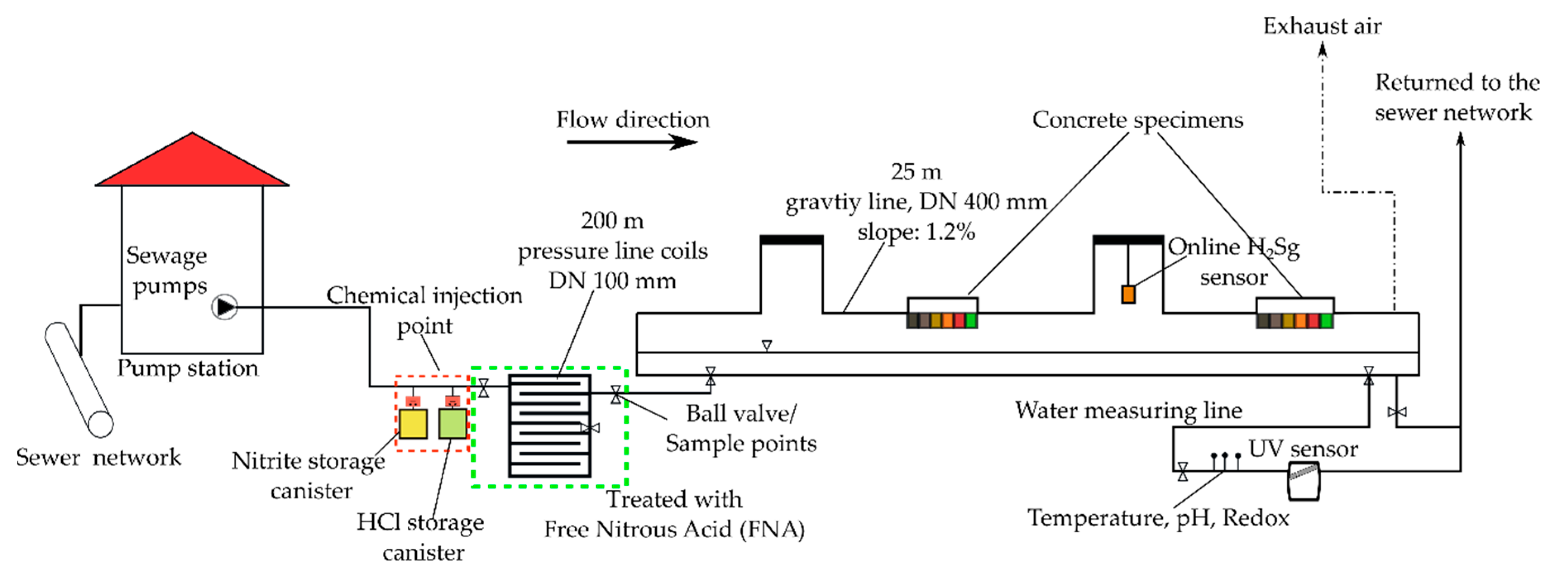
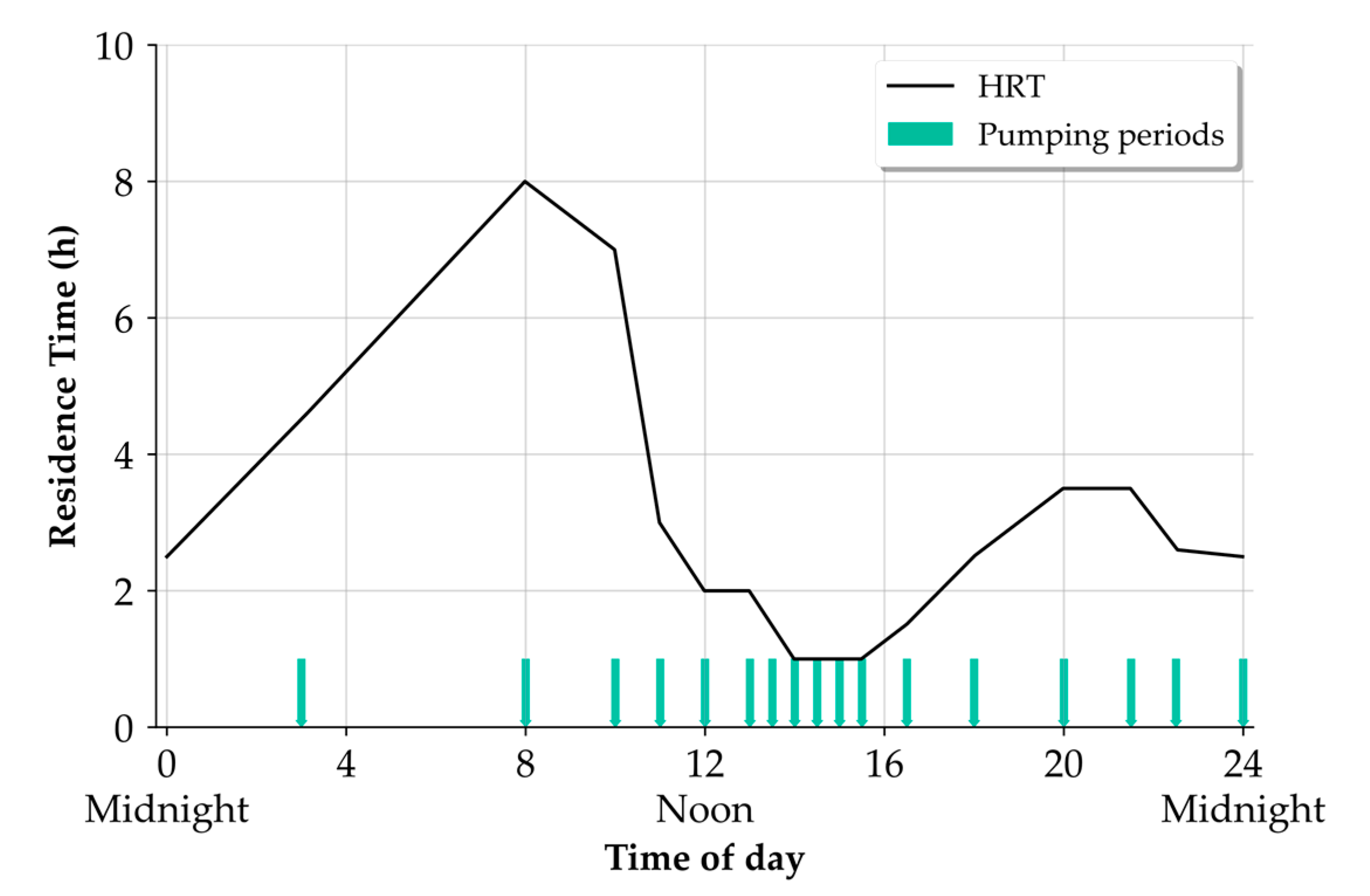
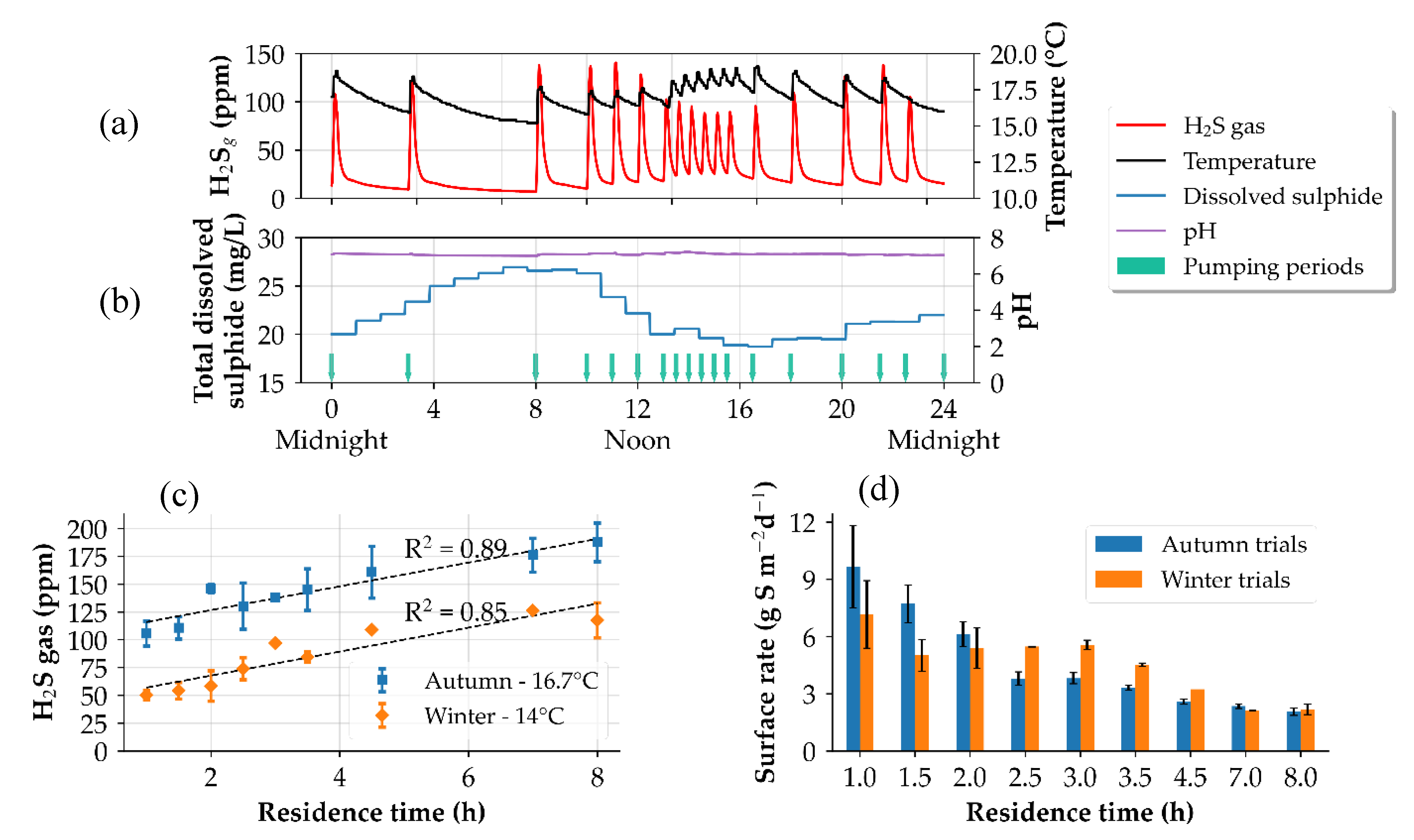
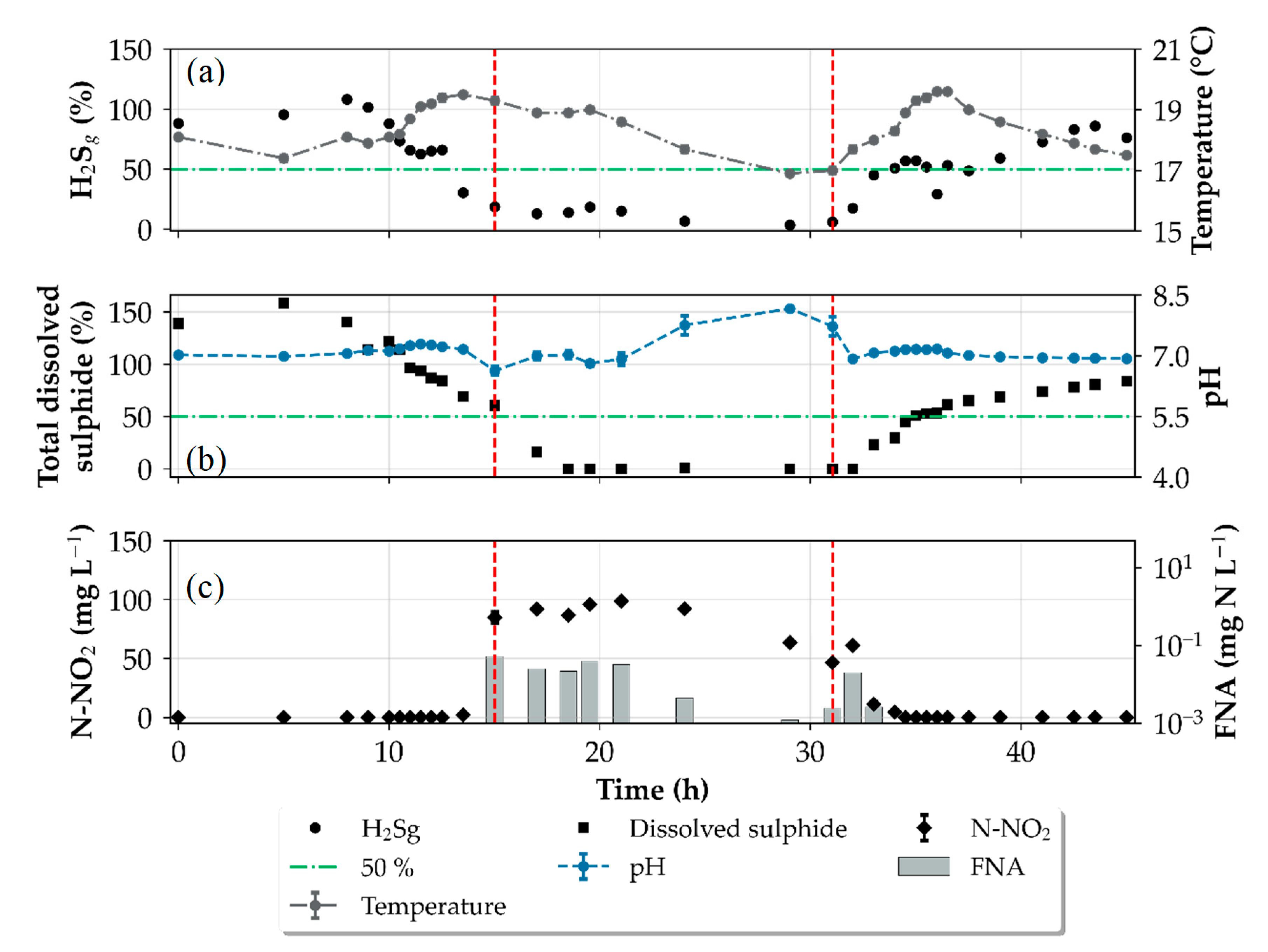
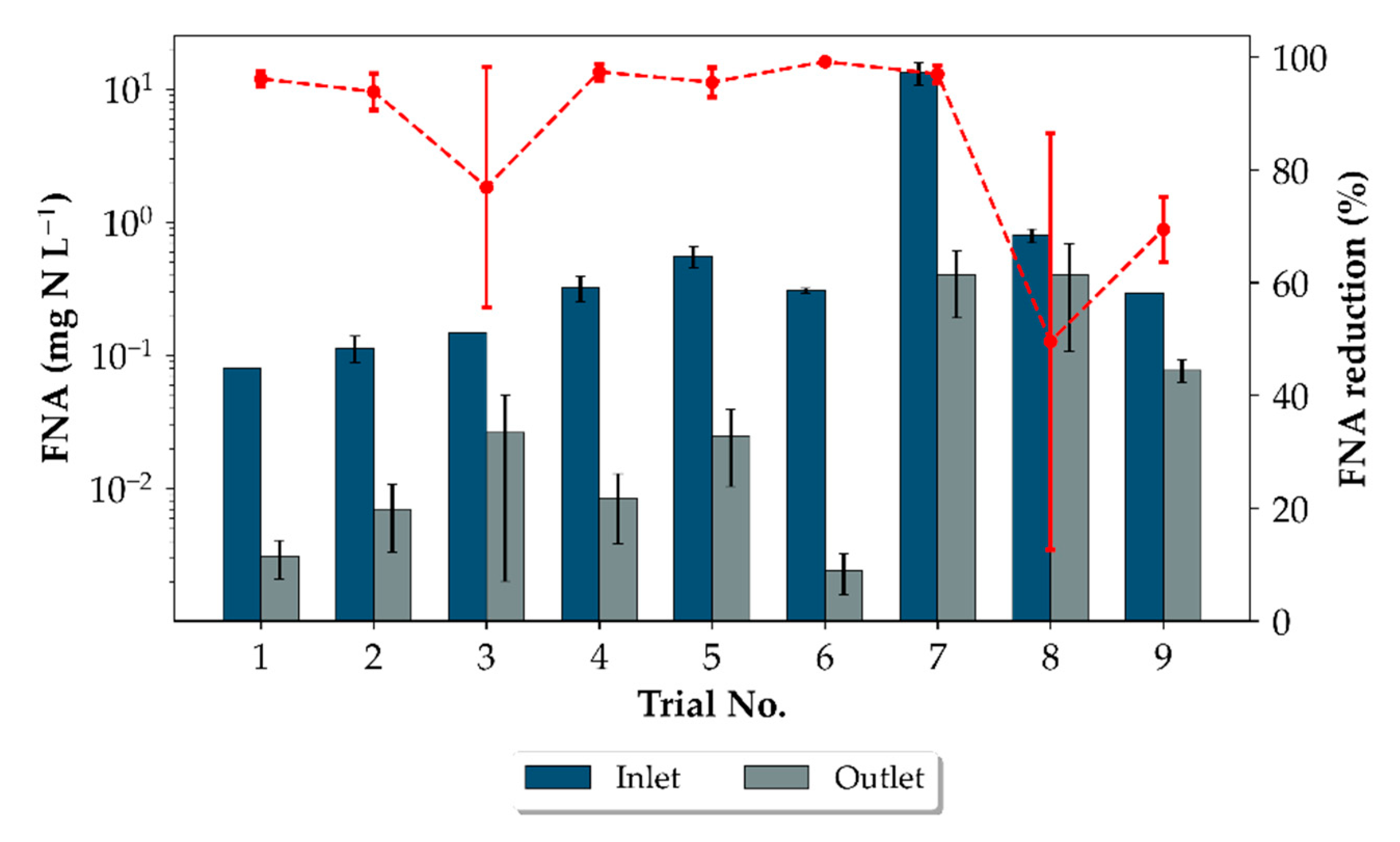
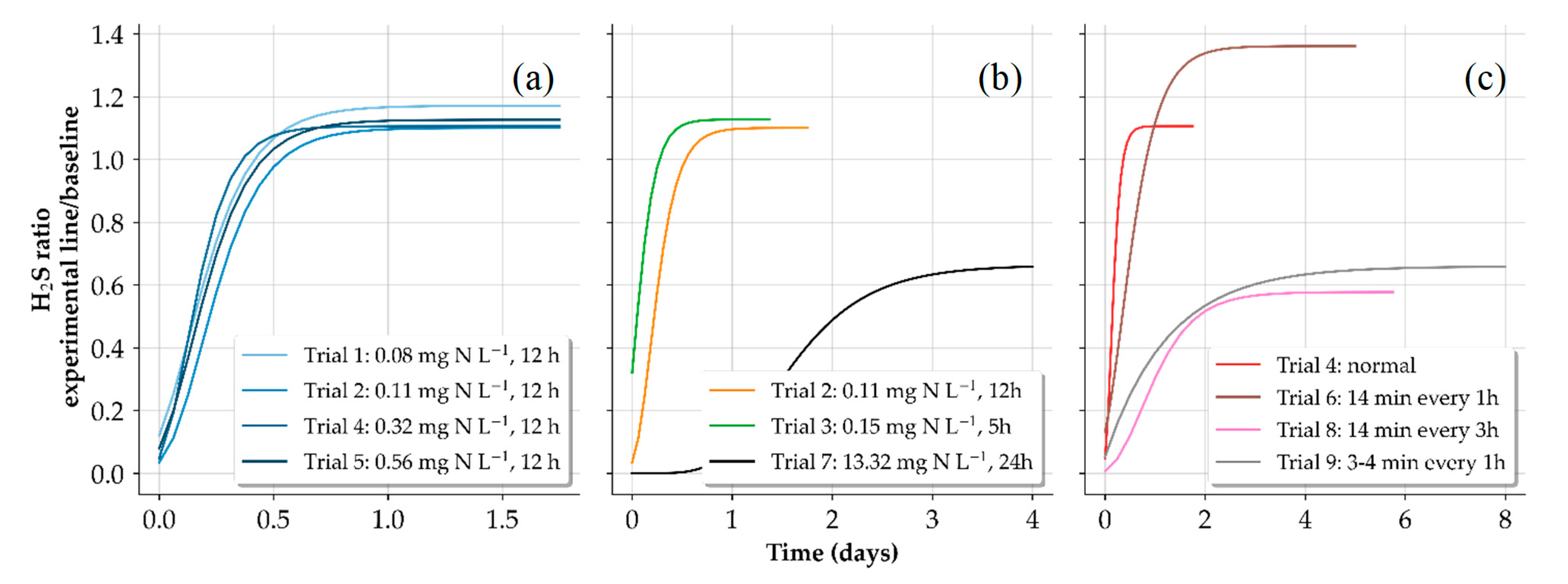
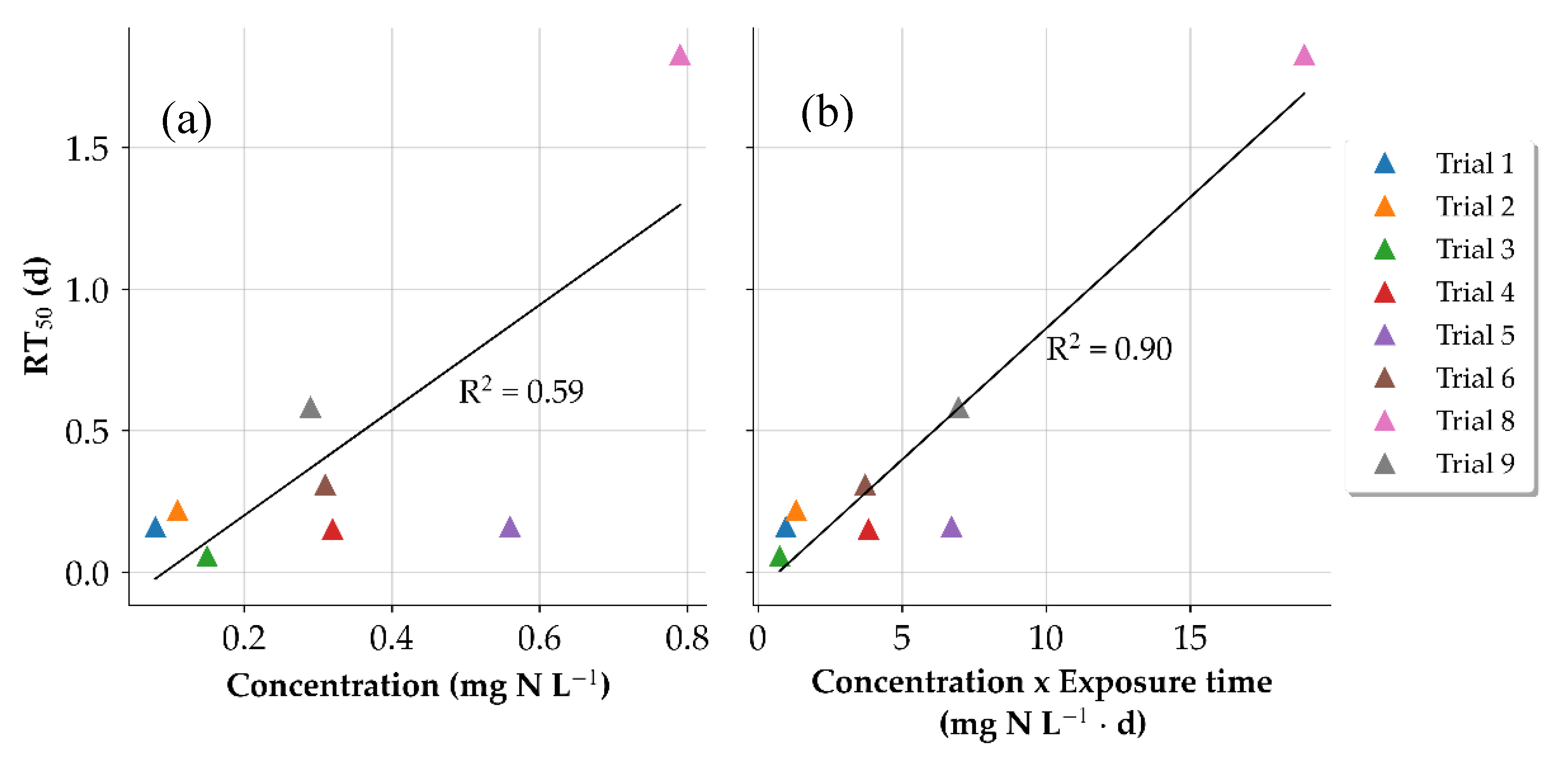
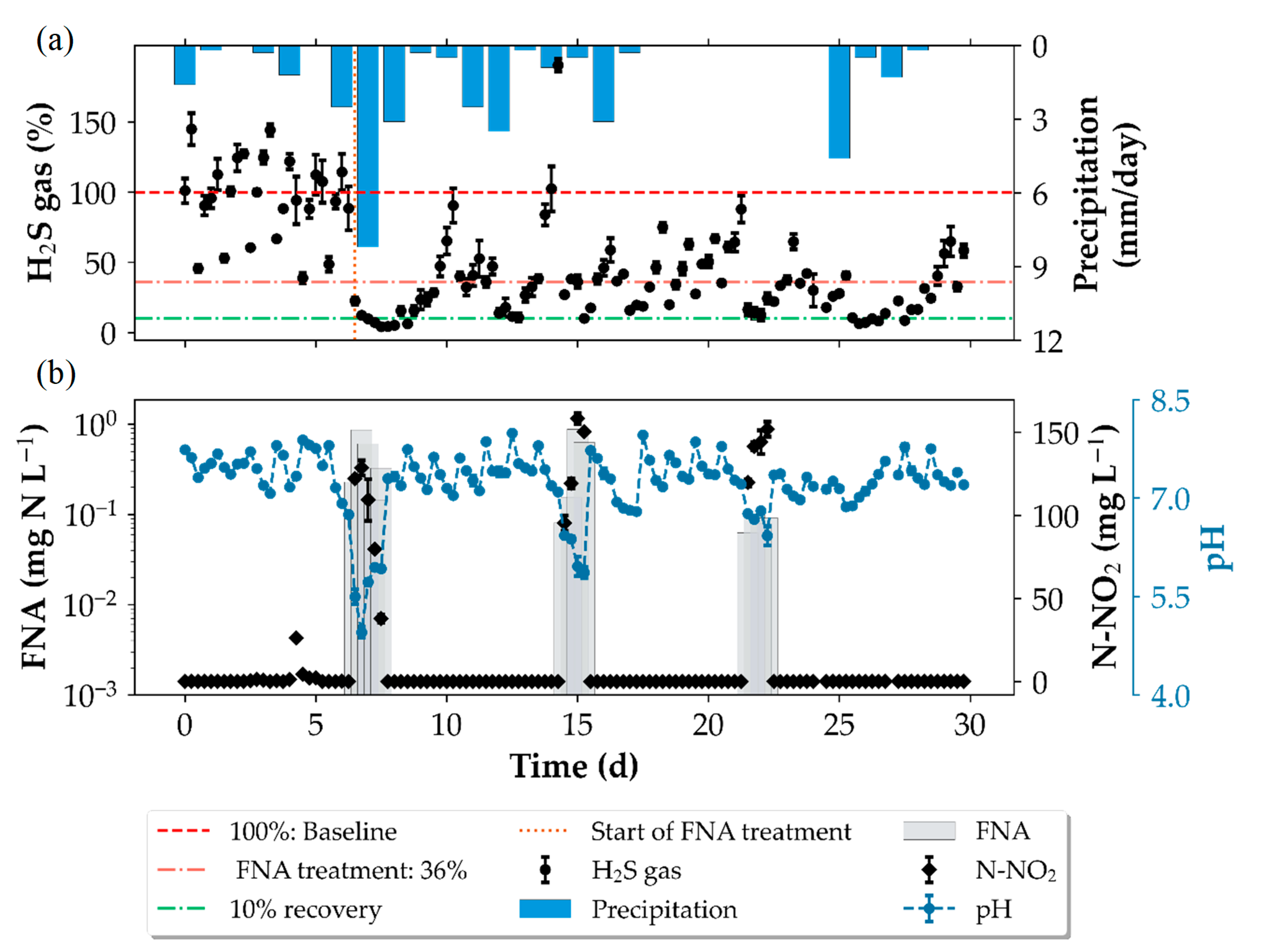
| Trial No. | FNA Dosed (mg N L−1) | Exp. * (h) | Average Temperature | Pumping Schedule | Aim of the Trial |
|---|---|---|---|---|---|
| 1 | 0.08 | 12 | 16.8 °C | Normal, 7 min | Low dosage and short exposure time |
| 2 | 0.11 | 12 | 17.6 °C | Normal, 7 min | Low dosage and short exposure time |
| 3 | 0.11 | 5 | 16.0 °C | Normal, 7 min | Very short exposure time |
| 4 | 0.32 | 12 | 18.3 °C | Normal, 7 min | Increased concentration |
| 5 | 0.56 | 12 | 17.9 °C | Normal, 7 min | Increased concentration |
| 6 | 0.30 | 12 | 16.3 °C | 14 min, every other cycle | Different pumping schedule to increase exposure |
| 7 | 13.32 | 24 | 14.4 °C | Normal, 7 min | Further increased concentration |
| 8 | 0.79 | 24 | 14.4 °C | 14 min every 3 h | Different pumping schedule to increase exposure |
| 9 | 0.25 | 24 | 9.6 °C | 3–4 min every hour | Different pumping schedule to increase exposure |
Publisher’s Note: MDPI stays neutral with regard to jurisdictional claims in published maps and institutional affiliations. |
© 2021 by the authors. Licensee MDPI, Basel, Switzerland. This article is an open access article distributed under the terms and conditions of the Creative Commons Attribution (CC BY) license (https://creativecommons.org/licenses/by/4.0/).
Share and Cite
Despot, D.; Reinhold, L.; Augustyniak, A.; Barjenbruch, M. Dosing Free Nitrous Acid as an Alternative Sulphide Control Technology for Pressure Sewers in Germany. Water 2021, 13, 1015. https://doi.org/10.3390/w13081015
Despot D, Reinhold L, Augustyniak A, Barjenbruch M. Dosing Free Nitrous Acid as an Alternative Sulphide Control Technology for Pressure Sewers in Germany. Water. 2021; 13(8):1015. https://doi.org/10.3390/w13081015
Chicago/Turabian StyleDespot, Daneish, Luisa Reinhold, Adrian Augustyniak, and Matthias Barjenbruch. 2021. "Dosing Free Nitrous Acid as an Alternative Sulphide Control Technology for Pressure Sewers in Germany" Water 13, no. 8: 1015. https://doi.org/10.3390/w13081015
APA StyleDespot, D., Reinhold, L., Augustyniak, A., & Barjenbruch, M. (2021). Dosing Free Nitrous Acid as an Alternative Sulphide Control Technology for Pressure Sewers in Germany. Water, 13(8), 1015. https://doi.org/10.3390/w13081015







